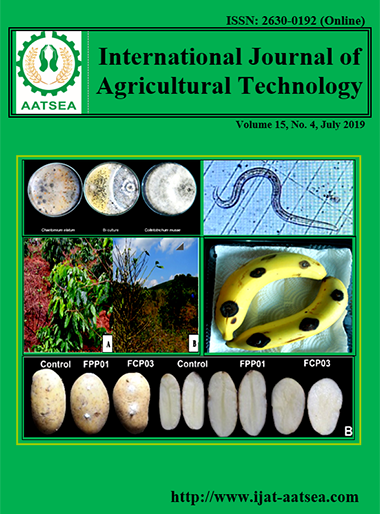Study on nematodes (Pratylenchus spp.) on Arabica coffee in the Northwestern Vietnam
Main Article Content
Abstract
Arabica coffee is one of the most important crop grown in Northwestern Vietnam. The growing area is estimated to be 20,000 ha, accounting for approximately 40% of Vietnam’s Arabica coffee area, and it mainly distributed in Son La and Dien Bien provinces. The climate and elevation of those areas are suitable for growing Arabica coffee. Especially, the coffee is recognized as one of the high quality in the world trade. However, Arabica coffee cultivation in this region has threatened by nematode disease, causing leaf fall, twig dieback, dry fruit and leading to reduce productivity. The survey results of 19 tea coffee gardens in 2 provinces in 2018 had 84.81% of the gardens infected with Pratylenchus spp. The nematode density ranged from 21.91 to 48.3 individuals/ 100g of soil and from 43.5 to 99.2 individuals/ 2g roots. After 6 months, infection of Pratylenchus spp in plants with the density of 10, 100 and 500 individuals/pot, in greenhouse conditions, disease index was 31.45%, 62.48% and 84.78%, respectively. It is the first report to detect Pratylenchus spp ijn Arabica coffee in Muong Ang (Dien Bien) and Son La.
Article Details

This work is licensed under a Creative Commons Attribution-NonCommercial-NoDerivatives 4.0 International License.
References
Bezooijen, J. van. (2006). Manual book: Methods and Techniques for Nematology. pp.20.
Campos, V. P., Sivapalan, P. and Gnanapragasam, N. C. (1990). Nematode parasites of coffee, cocoa and tea. Plant parasitic nematodes in subtropical and tropical agriculture, 387-430.
Cristina, I. and Herrera, S. (2011). Root-knot Nematodes and Coffee in Nicaragua: Management Systems, Species Identification and Genetic Diversity. (Doctoral Thesis). Swedish University of Agricultural Sciences Alnarp, Sweden.
European and Mediterranean Plant Protection Organization (2013). Nematode extraction. Bulletin OEPP/EPPO Bulletin, 43:471-495.
Loang, T. K., Sung, P. Q. and Mao, H. T. (2001). Control of nematode disease (Pratylenchus coffeae) on replanted coffee by cultivation practices. Science and Technology Journal of Agriculture and Rural Development, 9:637-639.
Roger, S and Dean, B. (2005). Management of plant pathogen collections. Australian Government Department of Agriculture, Fisheries and Forestry. Australia.
Tran, K. L. (2002). Study some causes of leaf yellowing phenomenon, root rot on Robusta coffee (Coffea canephora) at Dak Lak and prevention ability. (Doctoral Thesis). Vietnam National University of Agriculture, Vietnam.
Tran, N. C. and Nguyen, V. T. (2001). Coffee parasitic nematode in the northern provinces and the Western Highlands, Vietnam. Collection of studies on ecology and biological resources. Agriculture Publisher, pp.188-195.
Trinh, P. Q., de la Peña, E., Nguyen, C. N., Nguyen, H. X. and Moens, M. (2009). Plant-parasitic nematodes associated with coffee in Vietnam. Russian journal of Nematology, 17:73-82.
Trinh, P. Q., Waeyenberge, L., Nguyen, C. N. and Moens, M. (2012). Morphological and molecular diversity of Radopholus on coffee in Vietnam and description of R. daklakensis sp. n. from Robusta coffee. Nematology, 14:65-83.
Trinh, P. Q, Le, T. M. L., Nguyen, T. D., Nguyen, H. T, Liebanas, G. and Nguyen, T. A. D. (2018). Meloidogyne daklakensis n. sp. (Nematoda: Meloidogynidae), a new root-knot nematode associated with Robusta coffee (Coffea canephora Pierre ex A. Froehner) in the Western Highlands, Vietnam. Retrived from https://www.cambridge.org/core.
Vu, H. T. (2012). Research on technical methods of intensive cultivation of tea coffee in the direction of sustainable development for Northwest ecological sub-regions. Proceedings of the first national workshop on crop science, Vietnam Institute of Science and Technology Vietnam, pp.897-906.


